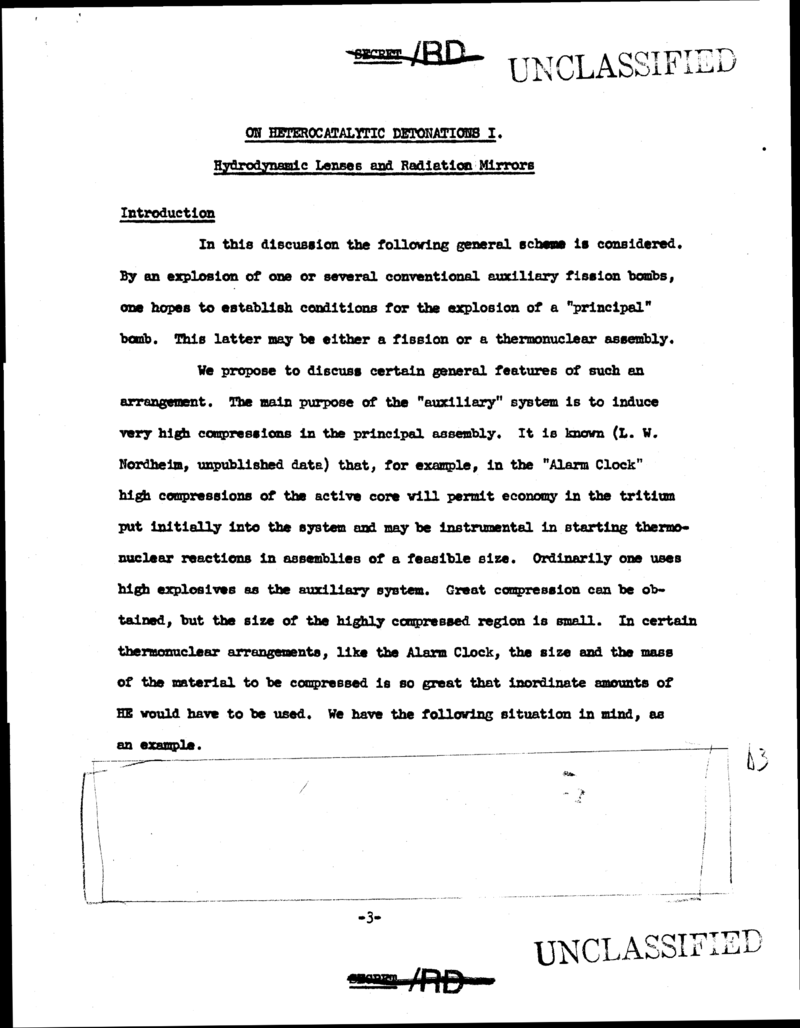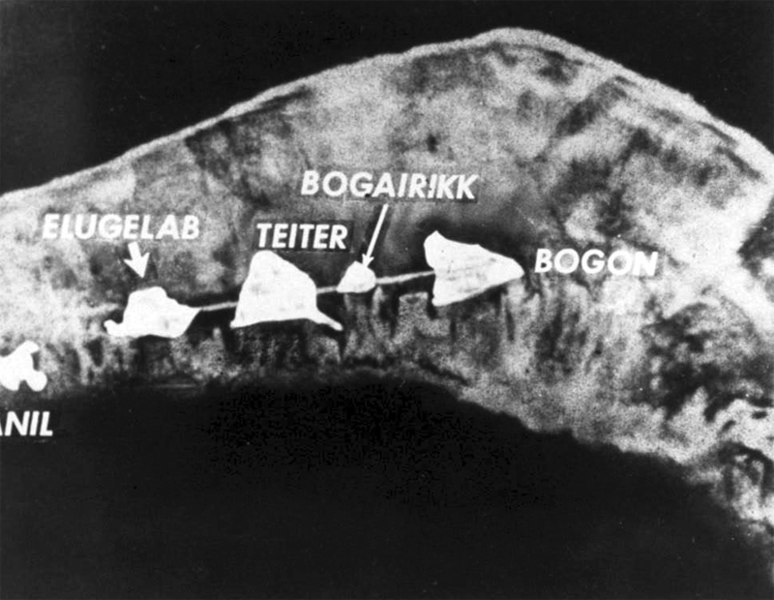Hydrogen bomb
The Teller–Ulam design is the nuclear weapon design concept used in most of the world’s nuclear weapons. It is colloquially referred to as “the secret of the hydrogen bomb” because it employs hydrogen fusion to generate neutrons. However, in most applications the bulk of its destructive energy comes from uranium fission, not hydrogen fusion. It is named for its two chief contributors, Edward Teller and Stanisław Ulam, who developed it in 1951 for the United States. It was first used in multi-megaton-range thermonuclear weapons. As it is also the most efficient design concept for small nuclear weapons, today virtually all the nuclear weapons deployed by the five major nuclear-armed nations use the Teller–Ulam design.

Its essential features, which officially remained secret for nearly three decades, are:
- separation of stages into a triggering “primary” explosive and a much more powerful “secondary” explosive.
- compression of the secondary by X-rays coming from nuclear fission in the primary, a process called the “radiation implosion” of the secondary.
- heating of the secondary, after cold compression, by a second fission explosion inside the secondary.
The radiation implosion mechanism is a heat engine exploiting the temperature difference between the hot radiation channel, surrounding the secondary, and the relatively cool interior of the secondary. This temperature difference is briefly maintained by a massive heat barrier called the “pusher”. The pusher is also an implosion tamper, increasing and prolonging the compression of the secondary, and, if made of uranium, which it usually is, it undergoes fission by capturing the neutrons produced by fusion. In most Teller–Ulam weapons, fission of the pusher dominates the explosion and produces radioactive fission product fallout.

The major figures in these breakthroughs were Ulam and Teller. In December 1950 Ulam had proposed a new fission weapon design, using the mechanical shock of an ordinary fission bomb to compress to a very high density a second fissile core. (This two-stage fission device was conceived entirely independently of the thermonuclear program, its aim being to use fissionable materials more economically.) Early in 1951, Ulam went to see Teller and proposed that the two-stage approach be used to compress and ignite a thermonuclear secondary. Teller suggested radiation implosion, rather than mechanical shock, as the mechanism for compressing the thermonuclear fuel in the second stage. On March 9, 1951, Teller and Ulam presented a report containing both alternatives, titled “On Heterocatalytic Detonations I: Hydrodynamic Lenses and Radiation Mirrors.” A second report, dated April 4, by Teller, included some extensive calculations by Frederic de Hoffmann and elaborated on how a thermonuclear bomb could be constructed. The two-stage radiation implosion design proposed by these reports, which led to the modern concept of thermonuclear weapons, became known as the Teller-Ulam configuration.


On November 1, 1952, the Teller–Ulam configuration was tested in the "Ivy Mike" shot at an island in the Enewetak atoll, with a yield of 10.4 megatons (over 450 times more powerful than the bomb dropped on Nagasaki during World War II). The device, dubbed the Sausage, used an extra-large fission bomb as a "trigger" and liquid deuterium—kept in its liquid state by 20 tons of cryogenic equipment—as its fusion fuel, and weighed around 80 tons altogether. Though an initial press blackout was attempted, it was soon announced that the U.S. had detonated a megaton-range hydrogen bomb.


The elaborate refrigeration plant necessary to keep its fusion fuel in a liquid state meant that the "Ivy Mike" device was too heavy and too complex to be of practical use. The first deployable Teller–Ulam weapon in the U.S. would not be developed until 1954, when the liquid deuterium fuel of the "Ivy Mike" device would be replaced with a dry fuel of lithium deuteride and tested in the "Castle Bravo" shot (the device was code-named the Shrimp). The dry lithium mixture performed much better than it was expected to, and the "Castle Bravo" device that was detonated in 1954 had a yield two and a half times greater than expected (at 15 Mt, it was also the most powerful bomb ever detonated by the United States). Because much of the yield came from the final fission stage of its uranium 238 tamper, it generated much nuclear fallout, which caused one of the worst nuclear accidents in U.S. history when unforeseen weather patterns blew it over populated areas of the atoll and Japanese fishermen on board the Daigo Fukuryu Maru.

In the Soviet Union, the design was known as Andrei Sakharov‘s “Third Idea“, first tested in 1955. Similar devices were developed by the United Kingdom, China, and France, though no specific code names are known for their designs.
The exact amount of contribution provided respectively from Ulam and Teller to what became known as the "Teller–Ulam design" is not definitively known in the public domain—the degree of credit assigned to Teller by his contemporaries is almost exactly commensurate with how well they thought of Teller in general. In an interview with Scientific American from 1999, Teller told the reporter:
I contributed; Ulam did not. I'm sorry I had to answer it in this abrupt way. Ulam was rightly dissatisfied with an old approach. He came to me with a part of an idea which I already had worked out and difficulty getting people to listen to. He was willing to sign a paper. When it then came to defending that paper and really putting work into it, he refused. He said, "I don't believe in it."






REFERENCES
Encyclopædia Britannica. Available in: https://www.britannica.com/technology/nuclear-weapon/The-first-hydrogen-bombs#ref521182. Access in: 04/10/2018.
Wikipedia. Available in: https://en.wikipedia.org/wiki/History_of_the_Teller%E2%80%93Ulam_design. Access in: 04/10/2018.
Wikipedia. Available in: https://en.wikipedia.org/wiki/Ivy_Mike. Access in: 04/10/2018.


























0 comments
Sign in or create a free account